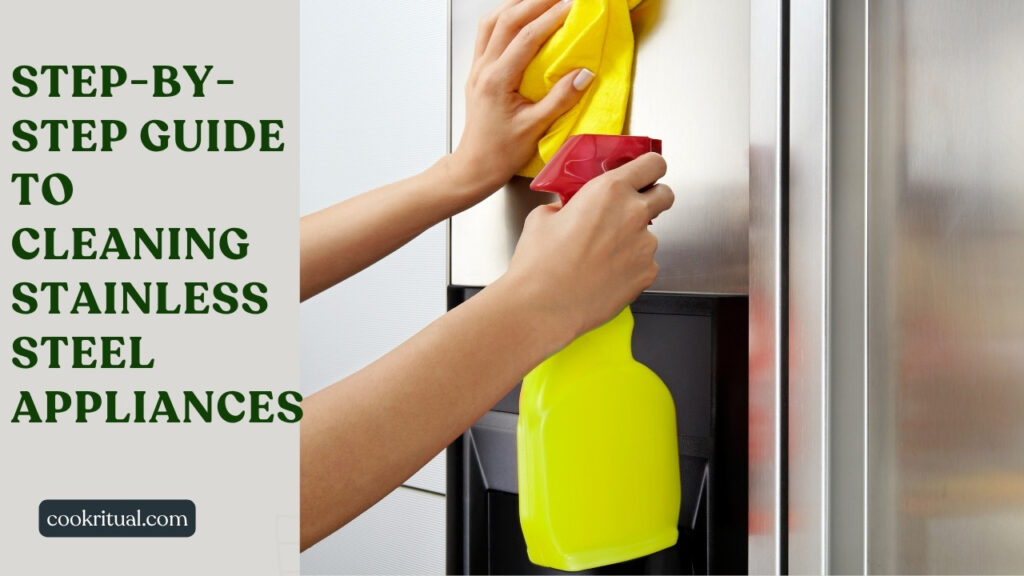Cleaning stainless steel appliances the right way is the key to keeping your kitchen looking polished, professional, and germ-free—all without the streaks and scratches. Whether it’s your refrigerator, oven, dishwasher, or microwave, these shiny surfaces need special care to maintain their sleek finish. Yet, many of us unknowingly use harsh cleaners or the wrong techniques, leading to dull spots or even permanent damage over time.
As health-conscious cooks and busy professionals, we know how vital it is to keep our kitchens clean and safe—especially the tools and surfaces we use every day. From smudged refrigerator doors to greasy oven handles, stainless steel appliances can be tricky to manage, but they don’t have to be. With the right step-by-step routine, we can save time, protect our appliances, and even improve the overall hygiene in our cooking space.
In this guide, we’ll walk through everything we need to know about cleaning stainless steel appliances—from the best products and natural DIY solutions to common mistakes to avoid and pro-level tips for a streak-free shine. Let’s get into it!
Contents
- 1 Why Cleaning Stainless Steel the Right Way Matters
- 2 Supplies You’ll Need for Streak-Free Results
- 3 Step-by-Step Instructions to Clean Stainless Steel Appliances
- 4 Common Mistakes to Avoid When Cleaning Stainless Steel
- 5 Daily, Weekly, and Deep Cleaning Routines
- 6 Cleaning Specific Appliances: Fridge, Oven, Dishwasher & More
- 7 Comparing Stainless Steel Cleaners: Commercial vs Homemade
- 8 Maintenance Tips to Keep Your Stainless Steel Looking New
- 9 Final Thoughts and Next Steps
Why Cleaning Stainless Steel the Right Way Matters
Stainless steel appliances look great—but only if we care for them the right way. These surfaces are durable and sleek, but they’re also magnets for fingerprints, water spots, and smudges. Over time, neglect or poor cleaning methods can dull their shine or even cause permanent scratches.
By using proper cleaning steps, we can:
- Keep appliances looking brand new
- Remove bacteria and grease build-up
- Prevent long-term damage from harsh chemicals
According to the U.S. Department of Agriculture, keeping kitchen surfaces clean plays a big role in reducing foodborne illnesses. That includes the outside of appliances, which many of us touch often while cooking.
Smart cleaning means longer-lasting appliances, better hygiene, and a more professional kitchen feel.
Supplies You’ll Need for Streak-Free Results

Before we begin cleaning, let’s gather the right tools. Using the wrong supplies can leave streaks, spots, or even scratch the surface.
Best stainless steel cleaners (store-bought and natural)
We can choose between commercial cleaners and DIY options—both work well when used correctly.
Recommended store-bought cleaners:
- Weiman Stainless Steel Cleaner & Polish
- Therapy Clean Stainless Steel Cleaner
- Bar Keepers Friend Soft Cleanser
These are made specifically to protect and shine stainless steel without causing damage.
DIY stainless steel cleaner:
- Mix equal parts white vinegar and water in a spray bottle.
- For extra shine, add a few drops of olive oil after cleaning.
According to Harvard Health, natural cleaners are a safer option for those with allergies or sensitivity to harsh chemicals.
Best tools for the job
- Microfiber cloths – soft, absorbent, and lint-free
- Spray bottle – to hold homemade solutions
- Paper towels (optional) – use only for drying, not scrubbing
- Soft sponge or polishing pad – for tougher stains
Using the right tools protects the stainless surface while delivering a shiny, streak-free finish.
Step-by-Step Instructions to Clean Stainless Steel Appliances

Cleaning stainless steel doesn’t have to be hard. Follow these four simple steps to remove grime, kill bacteria, and bring back that sparkle.
Step 1: Remove Surface Dust and Grime
Wipe the surface with a dry microfiber cloth to remove loose dirt and crumbs. This helps avoid scratching the finish during deep cleaning.
Step 2: Wipe with a Vinegar Solution (Natural Option)
Spray a 50/50 vinegar and water mix directly onto the surface. Let it sit for a few seconds, then wipe with a clean cloth. Vinegar helps cut through grease and kills bacteria. Learn more about its cleaning power from Cleveland Clinic.
Step 3: Buff with a Stainless Steel Cleaner or Olive Oil
Apply a small amount of store-bought cleaner or a few drops of olive oil to a soft cloth. Wipe gently, moving in the direction of the grain. This buffs away streaks and adds shine.
Step 4: Wipe Along the Grain for a Streak-Free Finish
Always check the direction of the stainless steel grain. It usually runs horizontally or vertically. Wipe in that direction for a clean, streak-free finish.
These steps work for most appliances, from refrigerators to ovens and microwaves, and take just a few minutes.
Common Mistakes to Avoid When Cleaning Stainless Steel
Even with good intentions, it’s easy to make mistakes when cleaning stainless steel. These small errors can leave streaks, cause damage, or shorten the life of your appliances.
Using Abrasive Tools or Harsh Cleaners
Never use steel wool, rough sponges, or bleach-based sprays. These can leave deep scratches or dull the finish. The U.S. Environmental Protection Agency (EPA) recommends choosing non-abrasive and fragrance-free cleaners for both safety and surface protection.
Instead, stick with microfiber cloths and gentle stainless steel cleaners made for appliances.
Cleaning in Circular Motions
Always wipe in the direction of the grain, not in circles. Circular scrubbing may leave swirl marks or push dirt into the grooves. Check your appliance—most stainless grains go either up-and-down or side-to-side.
Forgetting to Rinse or Dry
Leaving behind cleaner or water can lead to streaks or water spots. After wiping down, use a dry cloth to buff the surface. This step keeps the shine and removes leftover moisture or residue.
Mixing Cleaners
Never mix vinegar with bleach or other strong cleaners. It can create toxic fumes, which is dangerous in closed spaces. CDC guidelines strongly warn against mixing these chemicals at home.
Avoiding these common mistakes helps protect your stainless steel and keeps it looking brand new.
Daily, Weekly, and Deep Cleaning Routines
A simple cleaning routine can make a big difference. By sticking to a plan, we can avoid deep grime build-up and save time.
Daily: Quick Wipe-Down
- Use a dry microfiber cloth to remove fingerprints and smudges
- Wipe handles and doors after cooking
- Spray vinegar solution if needed
This quick clean takes under a minute and helps keep things looking fresh.
Weekly: Light Polish
- Use a store-bought stainless steel polish or a drop of olive oil
- Wipe in the direction of the grain for a streak-free finish
- Don’t forget to clean appliance edges and handles
This step keeps surfaces smooth and protects against stains.
Monthly: Deep Cleaning
- Use vinegar to remove grease build-up
- Clean hard-to-reach spots like under handles or inside creases
- Buff and seal with a polish or protectant
Following this schedule keeps your appliances in top shape and saves time in the long run. According to Mayo Clinic, a clean kitchen also promotes better food safety and reduces health risks.
Cleaning Specific Appliances: Fridge, Oven, Dishwasher & More
Not all stainless steel appliances are the same. Some need extra care depending on their shape, use, or location in the kitchen.
How to Clean a Stainless Steel Refrigerator
- Start with warm water and a few drops of dish soap
- Wipe doors, handles, and water dispensers with a microfiber cloth
- Use a polish for the final shine
Fridges tend to collect the most fingerprints and food splashes, so a weekly wipe-down is a must.
How to Clean a Stainless Steel Oven

- Let the oven cool completely
- Wipe with a vinegar solution to remove grease
- Avoid getting water into vents or knobs
- Buff with a soft cloth
Avoid abrasive oven cleaners unless the product says it’s safe for stainless steel.
Tips for Stainless Steel Dishwashers and Microwaves
- Clean the front with warm soapy water
- Use a toothbrush to reach into corners or handle bases
- Buff afterward using a small amount of olive oil or polish
For interior cleaning of dishwashers and microwaves, use tips from Consumer Reports, which help ensure safe and effective results.
Different appliances need different care, but the basics—gentle cleaning and regular upkeep—apply to all.
Comparing Stainless Steel Cleaners: Commercial vs Homemade
Choosing the right cleaner for your stainless steel appliances can be confusing. Both commercial cleaners and homemade solutions have their pros and cons.
Benefits of Commercial Stainless Steel Cleaners
- Formulated to remove tough stains and fingerprints
- Often contain polishes to add shine and protection
- Easy to use and widely available
Popular products like Weiman or Bar Keepers Friend are trusted by many and tested for safety. The Environmental Working Group (EWG) lists safer commercial options to consider.
Benefits of Homemade Cleaners
- Use simple, natural ingredients like vinegar, baking soda, and olive oil
- Budget-friendly and chemical-free
- Easy to customize for sensitive skin or allergies
Homemade cleaners are great for daily light cleaning and safe for households with children or pets. The National Sanitation Foundation (NSF) supports vinegar as an effective natural cleaner.
Both types work well when used properly. For heavy grime, commercial cleaners may save time. For regular upkeep, homemade solutions are gentle and eco-friendly.
Maintenance Tips to Keep Your Stainless Steel Looking New
Keeping stainless steel appliances looking fresh is easier with some simple habits.
Regular Polishing
Use a stainless steel polish or a few drops of olive oil weekly. This adds a protective layer that repels fingerprints and dust.
Avoid Harsh Chemicals and Abrasives
Never use bleach, ammonia, or steel wool. These can cause rust spots and scratches. Stick with gentle cleaners and soft cloths.
Clean Spills Immediately
Wipe up spills like juice or sauces right away to avoid staining. According to Harvard Health, preventing stains helps keep surfaces hygienic.
Keep a Dedicated Cleaning Cloth
Using the same microfiber cloth repeatedly keeps cleaning effective and prevents dirt buildup.
Final Thoughts and Next Steps
Cleaning stainless steel appliances well helps keep kitchens beautiful, safe, and hygienic. By using the right tools, avoiding common mistakes, and sticking to simple routines, anyone can achieve a streak-free shine that lasts.
Try combining commercial cleaners and natural solutions based on your needs. Remember to wipe with the grain and dry after each clean.


